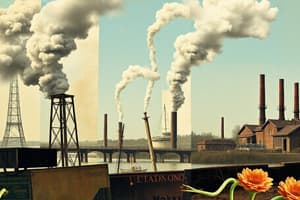Podcast
Questions and Answers
The ______ effect is the process through which heat is trapped near Earth's surface by substances known as 'greenhouse gases'.
The ______ effect is the process through which heat is trapped near Earth's surface by substances known as 'greenhouse gases'.
greenhouse
Which of these are classified as primary air pollutants? (Select all that apply)
Which of these are classified as primary air pollutants? (Select all that apply)
- Fumes (correct)
- SO3
- CO (correct)
- Hydrocarbons (correct)
- Ozone
- Smoke (correct)
- Dust (correct)
- NO2
The presence of CO2 in the atmosphere greater than normal due to exhaust from automobiles and industries is an example of qualitative pollutants.
The presence of CO2 in the atmosphere greater than normal due to exhaust from automobiles and industries is an example of qualitative pollutants.
False (B)
What is the chemical formula for sulfur dioxide?
What is the chemical formula for sulfur dioxide?
What is the name of the disease in humans caused by mercury poisoning?
What is the name of the disease in humans caused by mercury poisoning?
What is the main source of hydrocarbons in the atmosphere?
What is the main source of hydrocarbons in the atmosphere?
The most damaging gaseous pollutant for structures is sulfur dioxide.
The most damaging gaseous pollutant for structures is sulfur dioxide.
Which of the following is NOT a way to prevent or control air pollution?
Which of the following is NOT a way to prevent or control air pollution?
The ______ is a convention on wetlands that was signed in 1971 in the Iranian city of Ramsar. It was established with the goal of conserving and using wetlands wisely.
The ______ is a convention on wetlands that was signed in 1971 in the Iranian city of Ramsar. It was established with the goal of conserving and using wetlands wisely.
The Kyoto Protocol was an agreement that aimed to reduce the production of ozone-depleting substances but not to regulate the production and use of greenhouse gases.
The Kyoto Protocol was an agreement that aimed to reduce the production of ozone-depleting substances but not to regulate the production and use of greenhouse gases.
What is the main focus of the Convention on Biological Diversity?
What is the main focus of the Convention on Biological Diversity?
The Earth Summit in 1992, held in Rio de Janeiro, aimed to promote the concept of sustainable development, recognizing the interconnectedness of economic, social and environmental aspects.
The Earth Summit in 1992, held in Rio de Janeiro, aimed to promote the concept of sustainable development, recognizing the interconnectedness of economic, social and environmental aspects.
What is the main goal of the CITES convention?
What is the main goal of the CITES convention?
Which Indian Act was enacted for the protection and improvement of the environment, aiming to prevent environmental pollution in all forms?
Which Indian Act was enacted for the protection and improvement of the environment, aiming to prevent environmental pollution in all forms?
What is the main objective of the Forest Conservation Act, 1980?
What is the main objective of the Forest Conservation Act, 1980?
The Water (Prevention and Control of Pollution) Act, 1974 aimed to prevent pollution of water bodies due to industrial, agricultural, and domestic activities.
The Water (Prevention and Control of Pollution) Act, 1974 aimed to prevent pollution of water bodies due to industrial, agricultural, and domestic activities.
What was the primary reason for the enactment of the Air (Prevention and Control of Pollution) Act, 1981 in India?
What was the primary reason for the enactment of the Air (Prevention and Control of Pollution) Act, 1981 in India?
Which of these is NOT a right granted to Scheduled Tribes and other Traditional Forest Dwellers under the Forest Rights Act, 2006?
Which of these is NOT a right granted to Scheduled Tribes and other Traditional Forest Dwellers under the Forest Rights Act, 2006?
What is the main objective of the Scheduled Tribes and Other Traditional Forest Dwellers (Recognition of Forest Rights) Act 2006?
What is the main objective of the Scheduled Tribes and Other Traditional Forest Dwellers (Recognition of Forest Rights) Act 2006?
Noise pollution above 70 dB is considered to be damaging to living organisms.
Noise pollution above 70 dB is considered to be damaging to living organisms.
What are some of the effects of noise pollution on human health?
What are some of the effects of noise pollution on human health?
Noise pollution can affect the behavior and communication patterns of marine animals, including whales and dolphins.
Noise pollution can affect the behavior and communication patterns of marine animals, including whales and dolphins.
Which of the following is NOT a way to manage solid waste?
Which of the following is NOT a way to manage solid waste?
What are the three Rs of waste management?
What are the three Rs of waste management?
The Montreal Protocol was an international agreement aimed at the regulation of production and use of chemicals that contribute to the depletion of Earth's ozone layer.
The Montreal Protocol was an international agreement aimed at the regulation of production and use of chemicals that contribute to the depletion of Earth's ozone layer.
What is the primary objective of the Kyoto Protocol?
What is the primary objective of the Kyoto Protocol?
Which of these laws addresses pollution of water bodies, setting standards for the discharge of pollutants and establishing pollution control boards?
Which of these laws addresses pollution of water bodies, setting standards for the discharge of pollutants and establishing pollution control boards?
The Air (Prevention and Control of Pollution) Act, 1981 was enacted to address the issue of air pollution in India, focusing on reducing harmful emissions and promoting cleaner air.
The Air (Prevention and Control of Pollution) Act, 1981 was enacted to address the issue of air pollution in India, focusing on reducing harmful emissions and promoting cleaner air.
Flashcards
Environmental Pollution
Environmental Pollution
Any undesirable change in the physical, chemical, or biological characteristics of the environment (air, water, soil) that harms life or property.
Pollutants
Pollutants
Substances that cause environmental pollution.
Air Pollution
Air Pollution
Disruption of air composition by harmful gases, smoke, dust, or particles.
Water Pollution
Water Pollution
Signup and view all the flashcards
Soil Pollution
Soil Pollution
Signup and view all the flashcards
Noise Pollution
Noise Pollution
Signup and view all the flashcards
Quantitative Pollutants
Quantitative Pollutants
Signup and view all the flashcards
Qualitative Pollutants
Qualitative Pollutants
Signup and view all the flashcards
Primary Pollutants
Primary Pollutants
Signup and view all the flashcards
Secondary Pollutants
Secondary Pollutants
Signup and view all the flashcards
Biodegradable Pollutants
Biodegradable Pollutants
Signup and view all the flashcards
Non-biodegradable Pollutants
Non-biodegradable Pollutants
Signup and view all the flashcards
Contaminants
Contaminants
Signup and view all the flashcards
Suspended Particulate Matter (SPM)
Suspended Particulate Matter (SPM)
Signup and view all the flashcards
Greenhouse Effect
Greenhouse Effect
Signup and view all the flashcards
Ozone Depletion
Ozone Depletion
Signup and view all the flashcards
Acid Rain
Acid Rain
Signup and view all the flashcards
Solid Waste Management
Solid Waste Management
Signup and view all the flashcards
Sanitary Landfill
Sanitary Landfill
Signup and view all the flashcards
Composting
Composting
Signup and view all the flashcards
Incineration
Incineration
Signup and view all the flashcards
e-waste
e-waste
Signup and view all the flashcards
What is population growth?
What is population growth?
Signup and view all the flashcards
How does population growth affect resource use?
How does population growth affect resource use?
Signup and view all the flashcards
What is a carbon footprint?
What is a carbon footprint?
Signup and view all the flashcards
What is the Silent Valley Movement?
What is the Silent Valley Movement?
Signup and view all the flashcards
Why was the Silent Valley considered important?
Why was the Silent Valley considered important?
Signup and view all the flashcards
What is the Narmada Bachao Andolan?
What is the Narmada Bachao Andolan?
Signup and view all the flashcards
What is environmental justice?
What is environmental justice?
Signup and view all the flashcards
What is the National Green Tribunal?
What is the National Green Tribunal?
Signup and view all the flashcards
What are the main functions of the National Green Tribunal?
What are the main functions of the National Green Tribunal?
Signup and view all the flashcards
What are some examples of environmental communication and public awareness cases?
What are some examples of environmental communication and public awareness cases?
Signup and view all the flashcards
What is the Swachh Bharat Abhiyan?
What is the Swachh Bharat Abhiyan?
Signup and view all the flashcards
What is the National Environment Awareness Campaign?
What is the National Environment Awareness Campaign?
Signup and view all the flashcards
What is the National Green Corps?
What is the National Green Corps?
Signup and view all the flashcards
Study Notes
Environmental Pollution
- Environmental pollution encompasses the contamination of air, water, soil, and noise, with detrimental effects on living organisms and property.
- Pollutants can be primary (emitted directly) or secondary (formed from reactions).
- Common pollutants include mercury, arsenic, sulfur dioxide, and hydrocarbons.
Classification of Pollutants
- Quantitative Pollutants: Occur naturally but their concentration increases due to human activities. Example: Increased CO₂ levels from automobiles and industries.
- Qualitative Pollutants: Substances not naturally present in the environment, added by humans. Example: Insecticides.
- Primary Pollutants: Directly emitted into the environment. Example: Smoke, fumes, and hydrocarbons.
- Secondary Pollutants: Formed from reactions among primary pollutants in the atmosphere. Example: SO₃, NO₂, O₃, PAN, and aldehydes.
- Biodegradable Pollutants: Degraded by natural processes. Example: Domestic sewage and thermal pollutants.
- Non-biodegradable Pollutants: Do not decompose or decompose extremely slowly. Example: Plastics, Mercury, DDT.
- Contaminants: Undesirable foreign materials added by humans, changing the environment's composition.
Air Pollution
- Caused by increased population, rapid industrialization, urbanization, deforestation, and increased transportation.
- Major air pollutants include suspended particulate matter (dust, soot) and gaseous pollutants (CO₂, NOx, SO₂, etc.).
- SPM sources include vehicles, power plants, construction, and industries.
Gaseous Pollutants
- Carbon Dioxide (CO₂): Increased by fossil fuel combustion, leading to the greenhouse effect and climate change.
- Carbon Monoxide (CO): Incomplete fossil fuel combustion. Causes headaches, dizziness, and heart problems.
- Sulfur Dioxide (SO₂): Released from oil refineries. Causes eye irritation, allergic reactions, and asthma.
- Nitrogen Oxides (NOx): From vehicle exhausts, volcanic eruptions, and lightning. Causes eye irritation and asthma.
Acid Rain
- Resulting from sulfur dioxide (SO2) and nitrogen dioxide (NO2) emissions reacting with water vapor in the atmosphere forming sulfuric and nitric acid.
- Damages vegetation, buildings, and aquatic life.
Case Study: Taj Mahal
- Gaseous pollutants from Mathura Oil Refinery and other industries are causing acid rain, causing marble discoloration and decay (marble cancer) in the Taj Mahal.
Greenhouse Effect
- The trapping of heat near Earth's surface by greenhouse gases like CO2, CH4, CFCs, N₂O, O₃.
- These gases absorb outgoing infrared radiation, keeping Earth warmer than it would be otherwise.
- High Greenhouse gas concentrations contribute to global warming.
Ozone Depletion
- The gradual thinning of the ozone layer in the upper atmosphere due to the release of chlorofluorocarbons (CFCs) from industrial processes.
- CFCs react with ozone, breaking it down, reducing its protective capacity against harmful UV radiation.
- Results in increased skin cancer rates and damage to plants.
Other Contaminants
- Noise pollution originates from traffic, construction, and other human activities.
- Leads to hypertension, hearing loss, sleep disturbances, psychological problems, and impacts on wildlife and marine life.
- Heavy metal pollution is from industrial sources, notably metal processing, mining, and smelting.
- Leads to dangerous effects on human health, including nervous system damage, kidney dysfunction, and cancer.
- Heavy metals can also cause harm to wildlife.
Water Pollution
- Includes point (single identifiable sources) and non-point source (diffuse sources) pollution.
- Sources include industrial discharge, agricultural runoff (pesticides, fertilizers), domestic sewage, and oil spills.
- Effects are widespread; leading to toxicity for humans and other animals, contamination of ground and surface water, and harm to aquatic life.
- Thermal pollution: Discharge of heated water from power plants, affecting aquatic life due to temperature change.
- Eutrophication: Increased nutrients in water bodies, leading to excessive algae growth, oxygen depletion, and harm to aquatic life.
Soil Pollution
- Sources: Industrial discharge, improper waste management, agricultural practices (fertilizers, pesticides), construction/demolition activities.
- Effects: Reduced soil fertility, contamination of groundwater, harm to plants and animals.
- Some key aspects of soil pollution involve loss of soil fertility due to erosion, acid rain, and salinity.
Waste Management
- Disposal strategies for solid waste: landfilling, composting, and incineration.
- Importance of proper waste disposal to protect public health, environmental quality, and resource conservation.
Legislation
- Several Acts exist to protect the environment, such as the Environment (Protection) Act 1986, the Water (Prevention and Control of Pollution) Act 1974, the Air (Prevention and Control of Pollution) Act 1981, Scheduled Tribes and Other Traditional Forest Dwellers (Recognition of Forest Rights) Act 2006, etc.
- Each Act addresses specific environmental concerns, such as pollution control, conservation, sustainable use, and enforcement.
Studying That Suits You
Use AI to generate personalized quizzes and flashcards to suit your learning preferences.




